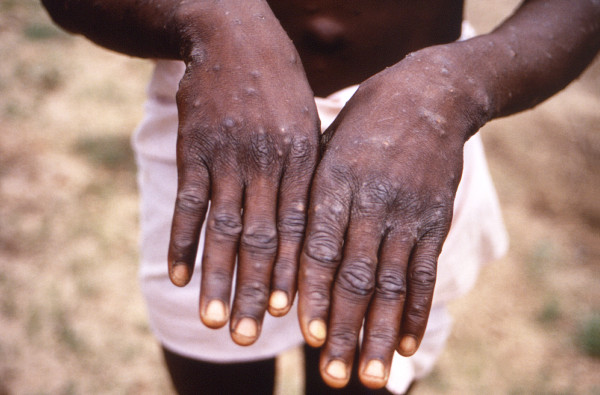A growing surge in mpox cases in Africa has led the World Health Organization (WHO) to declare a public health emergency.
The outbreak, primarily affecting the Democratic Republic of the Congo (DRC), has recorded over 14,000 cases this year.
Since 2023, the DRC has reported about 12,600 suspected cases and 580 deaths, a sharp rise from previous years, according to the CDC.
The WHO originally declared mpox a “public health emergency of international concern” (PHEIC) on 23 July 2022, which lasted until May 2023 by which time cases had been brought under control. The last time it made such a declaration was in January 2020 in response to the COVID-19 outbreak.
To date, more than 16,000 cases have been reported in more than 75 countries and the number of confirmed infections has risen 77% from late June through early July, according to WHO and UN data.
The World Economic Forum’s Head of Health and Healthcare, Shyam Bishen, says, “With this declaration, countries will need to invest significant resources in controlling this outbreak.”
He adds, “Fortunately, vaccines and drugs developed for smallpox may work well against monkeypox. But there is a very limited supply. While we encourage nations to share vaccines, treatments and other key resources for containing the outbreak, we believe a multistakeholder partnership is necessary among the private sector, governments, and international organizations to quickly scale up vaccine and treatment production for this disease.”
Europe was the epicentre of the first mpox outbreak, reporting more than 80% of cases worldwide in 2022. There have been no deaths reported from the virus outside of Africa, where there have been five to date.
While considered high in Europe, the global risk remains moderate and is unlikely to disrupt travel or trade.
The virus was discovered in 1970 and previous cases had been mainly in Africa. Cases outside of Africa have historically been rare, traced back to infected travellers or imported animals.
Here’s what you need to know about monkeypox and how public health authorities worldwide are responding.
What is monkeypox?
The monkeypox virus is a type of orthopoxvirus, in the same family of viruses that causes smallpox. The symptoms of monkeypox are similar – though less severe and less contagious – to smallpox.
There are two identified genetic clades – or groups – of the virus: the Congo Basin clade and the West African clade. The Congo Basin clade typically causes a more severe version of the disease and was thought to be more transmissible. Cases recently identified have been in the West African clade.
How does monkeypox spread?
Monkeypox is classified as a zoonosis, which means a disease that is transmitted between humans and animals. Cases often appear in tropical climates and rainforests where animals are carrying the virus, including types of squirrels, dormice and certain types of monkeys and rats. The disease is transmitted through bites, scratches or bush meat preparation.
Human-to-human transmission is limited and the virus is transmitted through direct contact with bodily fluids or skin lesions as well as indirect contact with lesion materials through items such as contaminated bedding or clothing. It can also spread through respiratory droplets but does not travel easily by air and requires direct, prolonged contact with someone who has an active rash.

What are the symptoms?
Monkeypox usually presents with a fever, rash and swollen lymph nodes. Early stages (1-3 days) involve headache and backache, sore muscles and lack of energy. Individuals with the infection will also often develop a rash 1-5 days from the onset of symptoms, starting as raised spots before turning into fluid-filled blisters, which ultimately turn into scabs and fall off.
What is the prognosis?
Monkeypox symptoms usually clear within 2-4 weeks without treatment. In recent times, the mortality rate has been between 3-6%, mostly among young children and immunocompromised individuals.
The cases diagnosed to date have been mild.
How is monkeypox being diagnosed?
All individuals who have tested positive have had the infection confirmed by a PCR test. Genomic sequencing was also used to confirm a case in Portugal.
How is it treated?
There is currently no medication for the monkeypox virus itself. However, the antiviral drugs cidofovir, brincidofovir and tecovirimat may be used.
The WHO is currently convening experts to discuss recommendations on vaccination.
How are public health authorities responding?
According to the WHO, health authorities are responding through the following measures:
- Ongoing public health investigations in non-endemic countries that have identified cases, including contact tracing, lab investigation, clinical management and isolation with supportive care.
- Genomic sequencing, where available, has determined the monkeypox virus clade(s) infecting individuals. Scientists are working to determine if the recent infections in Europe are related to strains in Africa.
- Vaccination for monkeypox, where available, is being deployed to manage close contacts, such as health workers.
- Robust surveillance, contact tracing and infection prevention and control: Strong surveillance and diagnostic systems, partnered with swift information-sharing, has ensured that health authorities can rapidly report and communicate on the outbreak.
- The WHO has also released emergency funds to countries with limited testing capabilities and supplies to establish monkeypox virus identification and sequencing.
Shyam Bishen explains, “The availability of a vaccine is encouraging news in the fight against monkeypox, but as with Covid-19, equitable distribution and access to vaccines will be a key challenge globally, due to uneven rollouts and uptake rates between high-income and low-and-middle-income countries.
“To counter this challenge, the World Economic Forum – in partnership with the Coalition for Epidemic Preparedness Innovations (CEPI) and the US National Academy of Medicine – has launched the Distributed Vaccine Manufacturing Collaborative. The Collaborative addresses inequitable vaccine access by supporting the establishment of a sustainable and robust global network of versatile vaccine manufacturing facilities capable of producing vaccines to protect individuals in pandemic and non-pandemic times.”
Source: World Economic Forum

